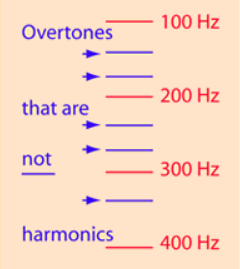오버톤
배음은 기음의 정수배에 대항하는 주파수 성분만 말하는 것이지만, 오버톤은 배음과 배음에 추가로 기음의 정수배가 아닌 주파수 성분들까지 같이 말하는 개념이다. 음정을 가진 악기1)들의 경우에는 기음과 배음의 조합으로 음색을 표현하고 배음이 아닌 성분이 거의 없지만, 음정을 가지지 않은 음색2)은 기음과 오버톤(배음 및 배음이 아닌 음)으로 이루어져 있고 배음이 아닌 성분이 비중이 크기 때문에 음정이 잘 분간되지 않는 소리로 표현되는 경향이 있다.
예를 들면 드럼과 같은 타악기의 음색에는 기음과 배음도 있지만, 그보다도 상당 수 배음이 아닌 오버톤이 많이 포함되어 있기 때문에, 드럼의 음색에 매우 큰 영향을 미친다.
음악과 음향학의 맥락에서 “오버톤“과 “배음“이라는 용어는 미묘한 차이가 있음에도 불구하고 종종 같은 의미로 사용된다.
Overtone
Harmonics refers to the frequency components that correspond to integer multiples of the fundamental frequency, while “overtones” encompass frequency components that are not necessarily integer multiples of the fundamental frequency. In the case of musical instruments with definite pitch (such as most melodic instruments), the timbre is typically expressed through a combination of harmonics and few non-harmonic components. However, for instruments without a definite pitch (such as most percussion instruments), their timbre is characterized by a significant presence of overtones, including both harmonic and non-harmonic frequencies. Due to the substantial presence of non-harmonic components in the timbre of non-pitched instruments, discerning a specific pitch can be challenging, resulting in a sound quality that lacks a clear pitch.
For instance, in the context of musical instruments like drums, the timbre comprises not only harmonics and overtones but also a substantial number of non-harmonic overtones. These non-harmonic overtones play a significant role in defining the timbral characteristics of drums.
In the context of music and acoustics, the terms “harmonics” and “overtones” are sometimes used interchangeably, despite subtle differences in their meanings.
[공지]회원 가입 방법
[공지]글 작성 및 수정 방법

